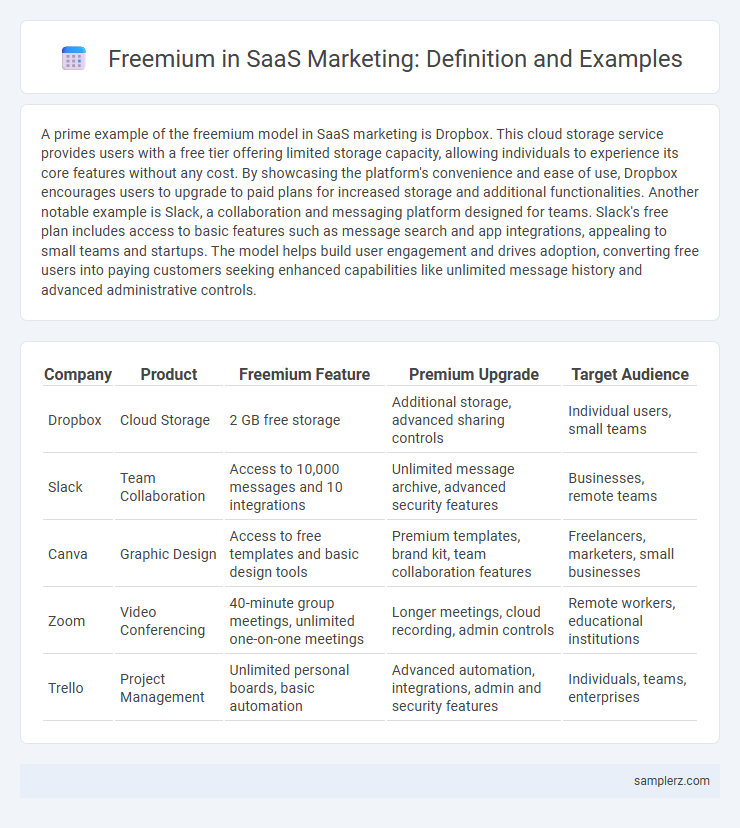A prime example of the freemium model in SaaS marketing is Dropbox. This cloud storage service provides users with a free tier offering limited storage capacity, allowing individuals to experience its core features without any cost. By showcasing the platform's convenience and ease of use, Dropbox encourages users to upgrade to paid plans for increased storage and additional functionalities. Another notable example is Slack, a collaboration and messaging platform designed for teams. Slack's free plan includes access to basic features such as message search and app integrations, appealing to small teams and startups. The model helps build user engagement and drives adoption, converting free users into paying customers seeking enhanced capabilities like unlimited message history and advanced administrative controls.
Table of Comparison
| Company | Product | Freemium Feature | Premium Upgrade | Target Audience |
|---|---|---|---|---|
| Dropbox | Cloud Storage | 2 GB free storage | Additional storage, advanced sharing controls | Individual users, small teams |
| Slack | Team Collaboration | Access to 10,000 messages and 10 integrations | Unlimited message archive, advanced security features | Businesses, remote teams |
| Canva | Graphic Design | Access to free templates and basic design tools | Premium templates, brand kit, team collaboration features | Freelancers, marketers, small businesses |
| Zoom | Video Conferencing | 40-minute group meetings, unlimited one-on-one meetings | Longer meetings, cloud recording, admin controls | Remote workers, educational institutions |
| Trello | Project Management | Unlimited personal boards, basic automation | Advanced automation, integrations, admin and security features | Individuals, teams, enterprises |
Understanding the Freemium Model in SaaS
The freemium model in SaaS offers basic features for free while charging for advanced functionalities, enabling companies to attract a large user base quickly. Platforms like Dropbox and Slack leverage this approach to convert free users into paying customers by providing valuable upgrades such as increased storage or premium support. Understanding user behavior through analytics is essential for optimizing conversion rates and maximizing revenue within the freemium structure.
Key Features of Successful Freemium SaaS Examples
Successful freemium SaaS examples like Dropbox and Slack offer essential features such as cloud storage with limited capacity and team messaging with basic integrations to attract users. These platforms provide seamless user experience, scalability options, and clear upgrade paths to premium tiers, ensuring user retention and conversion. Key features include intuitive onboarding, generous free-tier functionality, and regular feature updates that cater to both individual users and businesses.
Dropbox: Leading the Way with Freemium Strategies
Dropbox exemplifies successful freemium SaaS marketing by offering basic cloud storage for free while upselling premium plans with enhanced features such as increased storage capacity, advanced sharing controls, and priority support. This approach drives customer acquisition and converts free users into paying subscribers by addressing both casual and professional needs. The strategic balance of value in the free tier and compelling upgrades sustains Dropbox's competitive edge in cloud services.
Canva’s Freemium Model: Attracting Creative Users
Canva's freemium model offers a robust free plan with essential design tools and templates, attracting millions of creative users worldwide. By providing accessible features without upfront costs, Canva cultivates user engagement and encourages upgrades to premium subscriptions for advanced functionalities, such as brand kits and export options. This strategy effectively leverages user experience to boost customer acquisition and long-term revenue growth in the SaaS marketing landscape.
Zoom’s Rise Through a Freemium Approach
Zoom's rapid growth exemplifies the power of the freemium model in SaaS marketing, attracting millions by offering basic video conferencing free of charge while monetizing advanced features like extended meeting durations and increased participant capacity. Leveraging seamless user experience and viral sharing, Zoom transformed free users into paying customers, driving substantial revenue growth. This strategic freemium approach highlights how providing valuable core services at no cost can effectively scale user base and enhance market penetration.
Mailchimp: Growing User Base via Freemium Offerings
Mailchimp leverages a freemium model by offering essential email marketing tools at no cost, attracting millions of small businesses and startups. This strategy increases user acquisition and engagement by providing scalable features that encourage upgrading to premium plans for advanced analytics and automation. The freemium approach drives significant growth by converting free users into paying customers while maintaining a robust, active user base.
Slack: Building Collaboration with Free Tiers
Slack exemplifies the freemium model in SaaS by offering free tiers that enable teams to experience robust collaboration tools without upfront costs. This approach attracts millions of users by providing essential features like messaging, file sharing, and integrations, encouraging organic growth and upgrade potential. By balancing accessibility and premium capabilities, Slack drives user engagement and revenue through scalable subscription plans.
Trello: Engaging Teams with Freemium Project Management
Trello leverages a freemium model by offering core project management features for free, enabling teams to organize tasks with boards, lists, and cards without upfront costs. Its paid plans unlock advanced functionalities such as automation, larger file attachments, and enhanced security, incentivizing upgrades from free users. This approach drives user acquisition and retention by delivering immediate value while scaling with team needs.
Limitations and Upsell Tactics in SaaS Freemium Models
SaaS freemium models often impose limitations such as restricted features, storage capacity, or usage frequency to encourage users to upgrade to paid plans. Common upsell tactics include offering advanced analytics, priority support, or enhanced customization options to convert free users into paying customers. This strategy balances user acquisition with revenue growth by demonstrating value before pushing premium features.
Lessons Learned from Top SaaS Freemium Success Stories
Top SaaS freemium success stories like Dropbox, Slack, and Zoom demonstrate the importance of offering a functional free tier that delivers immediate user value while encouraging upgrades through premium features. These companies learned to optimize user onboarding, reducing friction to maximize trial-to-paid conversion rates by addressing key customer pain points. Tracking usage data and iterating product features based on user behavior proved crucial in balancing free and paid offerings to sustain growth and profitability.

example of freemium in SaaS Infographic
 samplerz.com
samplerz.com